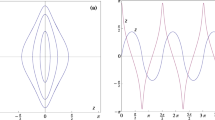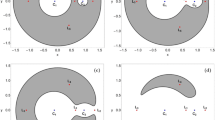Abstract
We study the stability of motion in the 3-body Sitnikov problem, with the two equal mass primaries (m 1 = m 2 = 0.5) rotating in the x, y plane and vary the mass of the third particle, 0 ≤ m 3 < 10−3, placed initially on the z-axis. We begin by finding for the restricted problem (with m 3 = 0) an apparently infinite sequence of stability intervals on the z-axis, whose width grows and tends to a fixed non-zero value, as we move away from z = 0. We then estimate the extent of “islands” of bounded motion in x, y, z space about these intervals and show that it also increases as |z| grows. Turning to the so-called extended Sitnikov problem, where the third particle moves only along the z-axis, we find that, as m 3 increases, the domain of allowed motion grows significantly and chaotic regions in phase space appear through a series of saddle-node bifurcations. Finally, we concentrate on the general 3-body problem and demonstrate that, for very small masses, m 3 ≈ 10−6, the “islands” of bounded motion about the z-axis stability intervals are larger than the ones for m 3 = 0. Furthermore, as m 3 increases, it is the regions of bounded motion closest to z = 0 that disappear first, while the ones further away “disperse” at larger m 3 values, thus providing further evidence of an increasing stability of the motion away from the plane of the two primaries, as observed in the m 3 = 0 case.
Similar content being viewed by others
References
Alekseev, V.M.: Quasirandom dynamical systems I, II, III. Math. USSR Sbornik 5, 73–128; 6, 505–560; 7, 1–43 (1968a, b, 1969a)
Alekseev V.M. (1969b). Quasirandom dynamical systems. Mat. Zametki 6(4): 489–498
Alfaro J.M. and Chiralt C. (1993). Invariant rotational curves in Sitnikov’s problem. Celest. Mech. Dyn. Astron. 55: 351–367
Belbruno E., Llibre J. and Olle M. (1994). On the families of the periodic orbits of the Sitnikov problem. Celest. Mech. Dyn. Astron. 50: 99–129
Chesley S.R. (1999). A global analysis of the generalized Sitnikov problem. Celest. Mech. Dyn. Astron. 73: 291–302
CorsJ. Libre J. (2004). The global flow of the parabolic restricted three-body problem. Celest. Mech. Dyn. Astron. 90: 13–33
Dvorak R. (1993). Numerical results to the Sitnikov problem. Celest. Mech. Dyn. Astron. 56: 71–80
Dvorak R. and Sun Y.S. (1997). The phase space structure of the extended Sitnikov-problem. Celest. Mech. Dyn. Astron. 67: 87–106
Hagel J. (1992). A new analytic approach to the Sitnikov problem. Celest. Mech. Dyn. Astron. 53: 267–292
Hagel J. and Lhotka Ch. (2005). A High order perturbation analysis of the Sitnikov problem. Celest. Mech. Dyn. Astron. 93: 201–228
Hagel J. and Trenkler T. (1993). A computer aided analysis of the Sitnikov problem. Celest. Mech. Dyn. Astron. 56: 81–98
Liu J. and Sun Y.S. (1990). On the Sitnikov problem. Celest. Mech. Astron. 49: 285–302
Mac Millan W.D. (1913). An integrable case in the restricted problem of three bodies. Astron. J. 27: 11–13
Marchal C. (1990). Three Body problem. Elsevier Science Publishers, Amsterdam, New York and Tokyo
Moser, J.: Stable and Random Motions in Dynamical Systems. In: Annals of Mathematics Studies No. 77. Princeton University Press and University of Tokyo Press, Princeton, New Jersey (1973)
Pavanini, G.: Sopra una nuova categoria di solutioni periodiche nel problema dei tre corpi. Annali di Mathematica, Serie III, Tomo XIII, 179 (1907)
Sitnikov C. (1960). The existence of oscillatory motions in the three-body problem. Dokl. Akad. Nauk USSR 133(2): 303–306
Skokos Ch. (2001). Alignment indices: a new, simple method for determining the ordered or chaotic nature of orbits. J. Phys. A: Math. Gen. 34: 10029–10043
Skokos Ch., Antonopoulos Ch., Bountis T.C. and Vrahatis M.N. (2003). How does the smaller alignment index (SALI) distinguish order from chaos. Prog. Theor. Phys. Supp. 150: 439–443
Skokos Ch., Antonopoulos Ch., Bountis T.C. and Vrahatis M.N. (2004). Detecting order and chaos on Hamiltonian systems by the SALI method. J. Phys. A:Math. Gen. 37: 6269–6284
Soulis, P., Bountis, T., Leftaki, M.: Regular and Chaotic Dynamics in Sitnikov’s Circular 3-Body Problem. In: Proc. of 1st International Conference, From Scientific Computing to Computational Engineering 1st IC-SCCE, Athens, 8–10 (2004)
Wodnar K.: New formulations of the Sitnikov problem. In: Roy A.E. (ed.) Predictability, Stability and Chaos in N-body Dynamical Systems, NATO ASI Series B272, Plenum Press, New York and London (1991)
Wodnar K. (1993). The original Sitnikov article new insights. Celest. Mech. Dyn. Astron. 56: 99–101
Author information
Authors and Affiliations
Corresponding author
Rights and permissions
About this article
Cite this article
Soulis, P., Bountis, T. & Dvorak, R. Stability of motion in the Sitnikov 3-body problem. Celestial Mech Dyn Astr 99, 129–148 (2007). https://doi.org/10.1007/s10569-007-9093-6
Received:
Revised:
Accepted:
Published:
Issue Date:
DOI: https://doi.org/10.1007/s10569-007-9093-6




